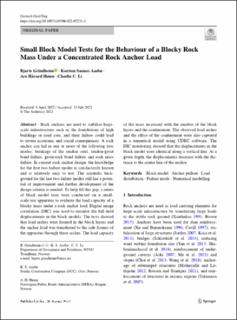| dc.contributor.author | Grindheim, Bjarte | |
| dc.contributor.author | Aasbø, Karsten Sannes | |
| dc.contributor.author | Høien, Are Håvard | |
| dc.contributor.author | Li, Charlie Chunlin | |
| dc.date.accessioned | 2023-01-11T08:14:22Z | |
| dc.date.available | 2023-01-11T08:14:22Z | |
| dc.date.created | 2022-08-15T09:35:49Z | |
| dc.date.issued | 2022 | |
| dc.identifier.citation | Geotechnical and Geological Engineering. 2022, . | en_US |
| dc.identifier.issn | 0960-3182 | |
| dc.identifier.uri | https://hdl.handle.net/11250/3042547 | |
| dc.description.abstract | Rock anchors are used to stabilise large-scale infrastructure such as the foundations of high buildings or road cuts, and their failure could lead to severe economic and social consequences. A rock anchor can fail in one or more of the following four modes; breakage of the tendon steel, tendon-grout bond failure, grout-rock bond failure and rock mass failure. In current rock anchor design, the knowledge for the first two failure modes is satisfactorily known and is relatively easy to test. The scientific background for the last two failure modes still has a potential of improvement and further development of the design criteria is needed. To help fill this gap, a series of block model tests were conducted on a small-scale test apparatus to evaluate the load capacity of a blocky mass under a rock anchor load. Digital image correlation (DIC) was used to monitor the full-field displacements in the block models. The tests showed that load arches were formed in the block layers and the anchor load was transferred to the side frames of the apparatus through these arches. The load capacity of the mass increased with the number of the block layers and the confinement. The observed load arches and the effect of the confinement were also captured in a numerical model using UDEC software. The DIC monitoring showed that the displacements in the block model were identical along a vertical line. At a given depth, the displacements decrease with the distance to the centre line of the anchor. | en_US |
| dc.language.iso | eng | en_US |
| dc.publisher | Springer | en_US |
| dc.rights | Navngivelse 4.0 Internasjonal | * |
| dc.rights.uri | http://creativecommons.org/licenses/by/4.0/deed.no | * |
| dc.title | Small Block Model Tests for the Behaviour of a Blocky Rock Mass Under a Concentrated Rock Anchor Load | en_US |
| dc.title.alternative | Small Block Model Tests for the Behaviour of a Blocky Rock Mass Under a Concentrated Rock Anchor Load | en_US |
| dc.type | Peer reviewed | en_US |
| dc.type | Journal article | en_US |
| dc.description.version | publishedVersion | en_US |
| dc.source.pagenumber | 18 | en_US |
| dc.source.journal | Geotechnical and Geological Engineering | en_US |
| dc.identifier.doi | https://doi.org/10.1007/s10706-022-02251-1 | |
| dc.identifier.cristin | 2042903 | |
| dc.relation.project | Norges forskningsråd: 303448 | en_US |
| cristin.ispublished | true | |
| cristin.fulltext | postprint | |
| cristin.qualitycode | 1 | |

